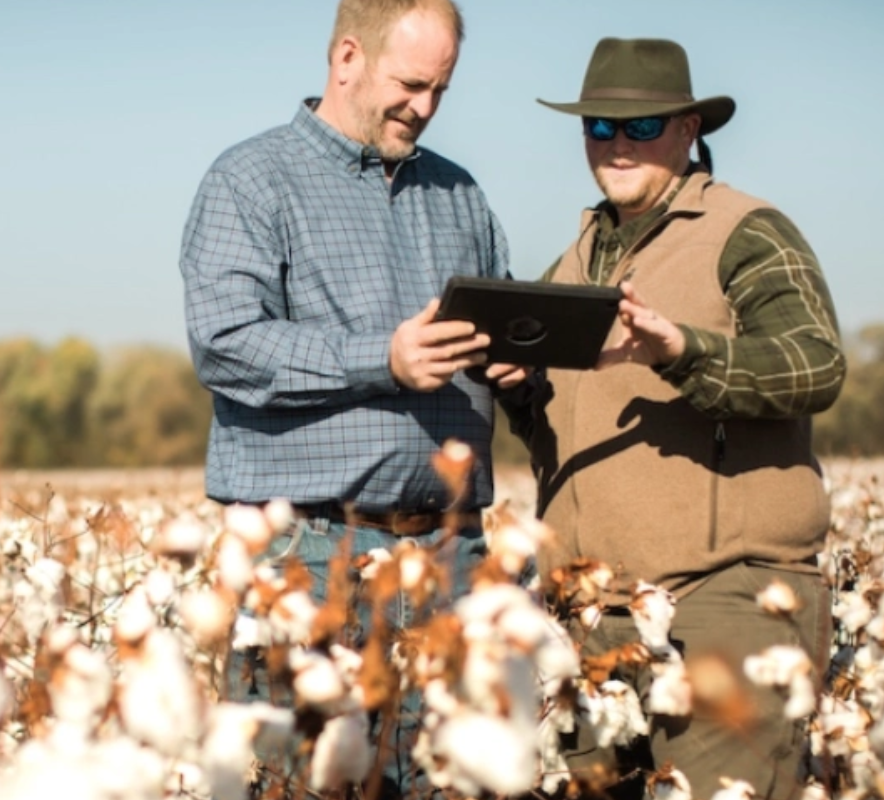
Global averages regarding cotton’s environmental impact can be misleading, as they fail to capture huge local variations in resource usage and impacts. Cotton is naturally drought tolerant and can grow in a variety of climate conditions, making it a viable crop in arid regions. Unlike many crops, cotton’s water needs are flexible—it can still grow and produce even when there is less water available. This is partially due to cotton’s tap root, which can grow as deep as 6 feet into the soil. Additionally, cotton’s flexibility allows it to flower throughout its life cycle—meaning, if there is a dry period it will take a break and then start flowering again when water is present.
Over the years, there have been many claims regarding how much water it takes to grow a single garment’s worth of cotton, which are commonly used to argue that cotton production is not sustainable. A figure often cited by individuals and organizations is that it takes roughly 20,000 liters of water to produce one cotton T-shirt.
A study that measured crop water productivity values for irrigated cotton revealed that with just one acre-inch of rain, modern cotton varieties tend to yield at least 50 pounds of lint and 75 pounds of seed. According to a 2017 report by Cotton Incorporated, this is enough to make more than 170 T-shirts and feed more than 10 cows. Breaking that down to a single T-shirt, the Cotton Incorporated LCA determined the cotton needed would consume less than two bathtubs of water, or 157 gallons of water.
Tracking every drop
Water has always been an important part of the sustainability conversation in the U.S. cotton industry, which has made significant progress in water management practices. Between 1980 and 2015, U.S. cotton growers decreased their water use by 79 percent. The Census of Agriculture’s 2018 Irrigation and Water Management Survey revealed that currently two-thirds of cotton grown in the U.S. is not irrigated, utilizing natural rainfall to grow. Roughly one-third uses irrigation to supplement natural rainfall, and only 2 percent is solely dependent on irrigation.
Launched in 2020, the U.S. Cotton Trust Protocol’s vision is to set a new standard in sustainable cotton production where full transparency is a reality and continuous improvement of environmental footprint is the central goal.
The program is built on a foundation of robust data capture, aggregation and reporting that drives continuous improvement across six key sustainability metrics: water use, energy efficiency, greenhouse gas emissions, soil conservation, soil carbon and land use.
Trust Protocol growers take a holistic approach to sustainable practices. For example, focusing on soil health through cover crops, minimum tillage and increasing soil organic matter improves crop resilience, which in turn impacts the soil’s ability to capture more natural rainfall and store it for drier periods. The reason for focusing on soil health is clear to see: Soil scientists report that for every 1 percent of organic matter content, the soil can hold 16,500 gallons of plant-available water per acre down to one foot deep.
Eighty-nine percent of Trust Protocol growers utilize precision agriculture technology, which has been a keystone for the success in ensuring they use the least amount of water possible to maximum effect. GPS field mapping pinpoints specific areas where water is required, and computer models predict water use based on the growth state of a plant. Weather data and infrared thermometers measure cotton leaf temperatures, which increase as plants begin to run out of water. Sensors can also monitor moisture and measure water evaporation from soil and plants, while sophisticated irrigation scheduling ensures water is applied only where and when necessary.
Quantifiable data leads to demonstrable outcomes
Measurable and verifiable data is a key factor when it comes to continuous improvement. With this information, growers can make informed decisions, which in turn improves growing practices to help preserve and restore critical habitats, protect watersheds (land areas that drain to bodies of water) and leave the land in better condition than it was found. Trust Protocol growers improved their water use efficiency by 14 percent in the 2021/22 crop year compared to the 2015 baseline, showing real progress toward meeting the 2025 National Goal of 18 percent increased water use efficiency.
ow in its third year, the Trust Protocol’s year-on-year data allows growers to systematically track continuous improvement and provides brands and retailers support for environmental claims and reporting. Accurate data collection sets the stage for appropriate decisions, and having this transparency will help the entire supply chain, ensuring we all work to protect Earth’s most vital resource: water.
Read more in Sourcingjournal.com
